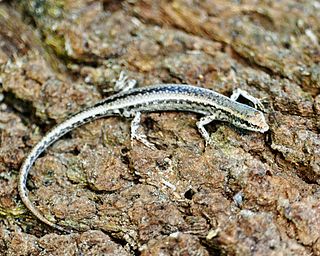
Cryptoblepharus is a genus of skinks, lizards in the family Scincidae. The genus contains at least 53 species.

Cryptoblepharus litoralis, the coastal snake-eyed skink or supralittoral shinning-skink, is a small skink found in North Queensland, Australia and New Guinea.

Cryptoblepharus australis, commonly called the inland snake-eyed skink, is a species of skink in the genus Cryptoblepharus.
Richard Sternfeld was a German-Jewish herpetologist, who was responsible for describing over forty species of amphibians and reptiles, particularly from Germany's African and Pacific colonies.
Cryptoblepharus yulensis is a species of skink, a lizard in the family Scincidae. The species is endemic to Papua New Guinea.

Cryptoblepharus buchananii, also known as Buchanan's snake-eyed skink, is a species of lizard in the family Scincidae. The species is endemic to Western Australia.
Cryptoblepharus cygnatus, also known commonly as Swanson's snake-eyed skink, is a species of lizard in the family Scincidae. The species is endemic to the Northern Territory in Australia.
Cryptoblepharus exochus, also known commonly as the noble snake-eyed skink, is a species of lizard in the family Scincidae. The species is endemic to the Northern Territory in Australia.

Cryptoblepharus gloriosus, the Glorioso snake-eyed skink, is a species of lizard in the family Scincidae. It is endemic to the Comoros Islands, and can be found on Mayotte, Mohéli, and the Glorioso Islands.

Cryptoblepharus juno, commonly known as Juno's snake-eyed skink, is a species of lizard in the family Scincidae. The species is endemic to the Northern Territory, Australia.
Cryptoblepharus megastictus, the blotched shinning-skink, is a species of lizard in the family Scincidae. It is endemic to the Northern Territory and Western Australia.

Cryptoblepharus metallicus, the metallic snake-eyed skink, is a species of lizard in the family Scincidae. It is endemic to the Northern Territory, Queensland, and Western Australia.

Cryptoblepharus nigropunctatus, known as the Ogasawara snake-eyed skink, is a species of lizard in the family Scincidae. It is endemic to the Bonin Islands of Japan.
Cryptoblepharus ochrus, also known commonly as the pale snake-eyed skink, is a species of lizard in the family Scincidae. The species is endemic to the Australian state of South Australia.

Cryptoblepharus plagiocephalus, Péron's snake-eyed skink or the callose-palmed shinning-skink, is a species of lizard in the family Scincidae. It is endemic to Australia.

Cryptoblepharus poecilopleurus, the mottled snake-eyed skink or Oceania snake-eyed skink, is a species of lizard in the family Scincidae. It is found throughout Oceania.
Cryptoblepharus ruber, also known as the tawny snake-eyed skink, is a species of lizard in the family Scincidae. It is endemic to Western Australia and Northern Territory.
Cryptoblepharus tytthos, also known commonly as the pygmy snake-eyed skink, is a species of lizard in the family Scincidae. The species is endemic to the Australian state of Western Australia.
Cryptoblepharus ustulatus, also known commonly, as the russet snake-eyed skink, is a species of lizard in the family Scincidae. The species is endemic to the Australian state of Western Australia.
Cryptoblepharus wulbu, also known commonly as the spangled snake-eyed skink, is a species of lizard in the family Scincidae. The species is endemic to the Northern Territory in Australia.











